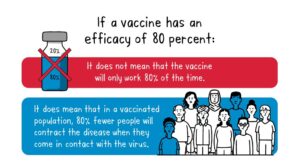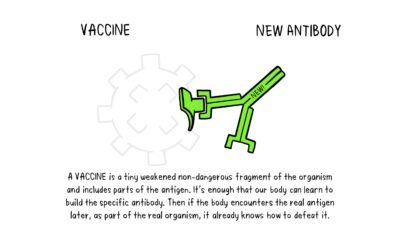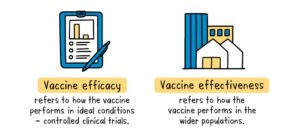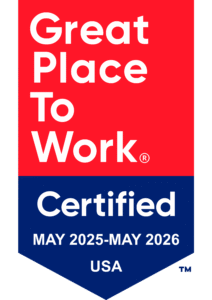Answers to Your Top 10 Immunization Questions
Over the years, and especially since the development and release of the COVID-19 vaccinations, we have received numerous questions about immunizations – effectiveness, side effects, ingredients, etc. We understand the hesitancy that some people are feeling and want to provide insight and resources to help answer some of the more common questions regarding immunizations.
How do vaccines work?
Think of vaccines like the military. Vaccines train our immune systems to create proteins called antibodies, which are responsible for fighting diseases in our bodies. Antibodies are like soldiers and are specially trained to fight a specific disease. When we get a vaccine, our bodies are exposed to a version of the disease that has been already killed or weakened. This helps our immune system create antibodies to fight this disease without getting sick – like completing basic training prior to being deployed.
Once the body processes the vaccine and produces antibodies, it also creates antibody-producing memory cells, which remain alive even after the disease is defeated. If the body is exposed to the same disease again, the antibody response is faster and more effective than the first time around because the memory cells are ready to pump out antibodies in defense. ¹
If you are exposed to a disease pre-vaccination, your body will have to create the antibodies and fight the disease simultaneously, putting an immense strain on your immune system.

Why aren’t vaccines 100% effective?
Vaccines are not always 100% effective because everyone is different. Each person’s immune system responds differently to vaccinations, much like how we all respond differently to medications. Most have a similar outcome, but not every medication is effective for everyone. However, vaccines are still one of the most effective weapons we have against disease. They work in 85% to 99% of cases, greatly reducing your risk of serious illness (particularly when more people are vaccinated) and giving diseases fewer chances to take hold. ² Even when not 100% effective, the vaccine can still help lessen the impact and side effects of the disease if you are exposed.

Can I get sick from a vaccine?
The risk of getting a disease from a vaccination is extremely small. Vaccines that are made with killed versions of pathogens—or with only a part of the pathogen—are not able to cause illness. When a person receives these vaccines, it is impossible for them to become ill with the disease. ³
Only immunizations made from weakened (also called attenuated) live viruses, like the chickenpox (varicella) and measles-mumps-rubella (MMR) vaccines, could possibly make a child develop a mild form of the disease. In these few cases, it is almost always less severe than if a child became infected with the disease-causing virus itself. However, for those with weakened immune systems, such as those being treated for cancer, should speak with their doctor about which vaccines are best for their unique needs. ²

Why are so many vaccines given to infants?
Newborn babies are immune to many diseases because they have antibodies from their mothers. However, this immunity goes away during the first year of life. If an unvaccinated child is exposed to a disease, the child’s body may not be strong enough to fight the disease. Before vaccines, many children died from diseases that vaccines now prevent, such as whooping cough, measles, and polio. Those same viruses exist today, but because babies are protected by vaccines, we don’t see these diseases nearly as often. ⁴ Some strains, through vaccination efforts, have even been certified as eradicated.
The recommended vaccination schedule for the first 2 years of life protects infants and children by providing immunity early in life, before they are likely to come into contact with dangerous diseases. The consequences of these diseases can be serious or even life-threatening for infants and young children especially. ⁵
Why do some vaccines require boosters?
Some vaccines do not provide as much immunity as possible with the first dose, so a second or “booster” dose is required. An example of this is some of the COVID-19 vaccines; early studies found that both Pfizer and Moderna provoked a relatively weak immune response when given as just one dose. However, there is a significantly stronger immune response when the second dose is given. Essentially, the first vaccine starts the antibody-building process and the second dose kicks production up to levels needed to better fight the disease. ⁶ Some boosters are needed a short period of time after the initial dose, such as the two-dose Shingrix series for shingles; others are needed less often but throughout your lifetime, like tetanus shots administered every 10 years.
Do vaccines cause autism?
No, vaccines do not cause autism. Numerous studies have been completed since this initial claim was released in 1998 and no such link has been discovered between vaccines and autism. In fact, the study that suggested a possible link between autism and the MMR vaccine was retracted in 2004 and the doctor who published it lost his medical license. Even before it was discredited and declared fraudulent, the study was rejected by all major health organizations, including the American Academy of Pediatrics (AAP), the National Institutes of Health (NIH), the Centers for Disease Control and Prevention (CDC), and the World Health Organization (WHO). ²
Are vaccines linked to long-term health problems?
The initial safety of a vaccine is tested repeatedly through clinical trials before it is licensed, and it is continually reevaluated over years as millions of doses are administered. Even the COVID-19 vaccines went through testing and clinical trials prior to being released, and other coronavirus vaccines have been studied for more than 50 years. Based on how vaccines work, there is not a plausible biologic reason to believe that vaccines would cause any serious long-term effects. Based on more than 50 years of data with vaccines, the likelihood that a vaccine will cause unanticipated long-term problems in the future is extremely low. ⁷
Are the ingredients in vaccines harmful to humans?
Many elements may appear in the ingredient list of a vaccine, but it’s important to pay attention to the amount of any element listed. Different vaccines have different ingredients, but none of them contain enough of any “harmful ingredient” to cause negative health effects. Aluminum is used in some vaccines to improve immune response; infants get more aluminum through breast milk or formula than vaccines. Formaldehyde is used to detoxify certain viruses — humans normally have formaldehyde in the blood stream at levels higher than in vaccines. Thimerosal, a mercury-based preservative, is used in some influenza vaccines to prevent contamination but is removed at the end of the manufacturing process. Any remaining amount is so small that it is not possible for it to have any effect. ⁸
Does mRNA change your DNA?
No, mRNA does not change your DNA. While messenger RNA (mRNA) vaccines are new, scientists have been studying mRNA technology for many years. Unlike traditional vaccines that use a killed or weakened virus, mRNA simply teaches your body how to make a protein that triggers an immune response. mRNA never enters the nucleus of the cell, which is where DNA is kept — and our bodies break down and get rid of the mRNA once it has made the protein. Many scientists predict that more vaccines will be created using mRNA technology in the future. ⁹
What do vaccine efficacy and vaccine effectiveness mean?
The World Health Organization defines efficacy as:
“A vaccine’s efficacy is measured in a controlled clinical trial and is based on how many people who got vaccinated developed the ‘outcome of interest’ (usually disease) compared with how many people who got the placebo (dummy vaccine) developed the same outcome. Once the study is complete, the numbers of sick people in each group are compared, in order to calculate the relative risk of getting sick depending on whether or not the subjects received the vaccine. From this we get the efficacy – a measure of how much the vaccine lowered the risk of getting sick. If a vaccine has high efficacy, a lot fewer people in the group who received the vaccine got sick than the people in the group who received the placebo.” ¹⁰
Meanwhile, vaccine effectiveness is defined as:
“Vaccine effectiveness is a measure of how well vaccines work in the real world. Clinical trials include a wide range of people – a broad age range, both sexes, different ethnicities and those with known medical conditions – but they cannot be a perfect representation of the whole population. The efficacy seen in clinical trials applies to specific outcomes in a clinical trial. Effectiveness is measured by observing how well the vaccines work to protect communities as a whole. Effectiveness in the real world can differ from the efficacy measured in a trial, because we can’t predict exactly how effective vaccination will be for a much bigger and more variable population getting vaccinated in more real-life conditions.” ¹⁰
Summarized, efficacy is how well the vaccine performs in trials, where everything else is controlled as much as possible and is closely monitored. Effectiveness is how it performs in the real world with lots more people and lots more variables.

We highly encourage you to talk with our team or your healthcare provider about any additional questions or concerns you may have with vaccines. Getting vaccinated against diseases is the best way to help protect our community, especially since the most vulnerable are often not eligible for many vaccines. For more information on the immunizations we offer, please visit.
Sources
¹ https://www.who.int/news-room/feature-stories/detail/how-do-vaccines-work
² https://kidshealth.org/en/parents/fact-myth-immunizations.html
³ https://www.historyofvaccines.org/content/articles/top-20-questions-about-vaccination
⁴ https://www.cdc.gov/vaccines/vac-gen/howvpd.htm
⁵ https://www.cdc.gov/vaccines/parents/FAQs.html
⁶ https://www.healthline.com/health/why-two-doses-of-covid-vaccine#why-two-doses
⁷ https://www.cdc.gov/vaccines/parents/tools/parents-guide/parents-guide-part4.html
⁹ https://www.cdc.gov/coronavirus/2019-ncov/vaccines/different-vaccines/mrna.html
¹⁰ https://www.who.int/news-room/feature-stories/detail/vaccine-efficacy-effectiveness-and-protection
